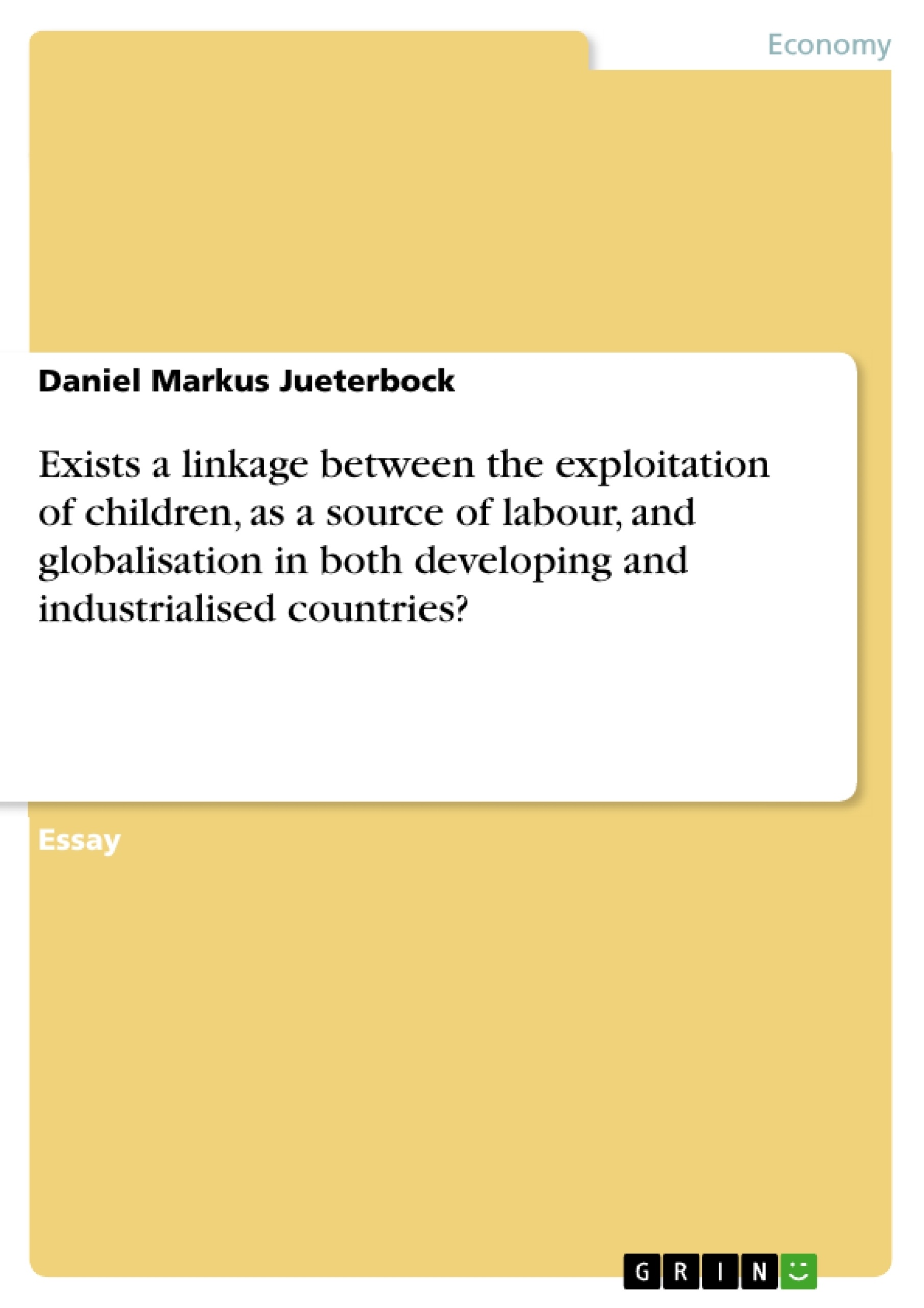This report tries to evaluate the question whether there is a linkage between globalisation and child labour in developing and industrialised countries. It takes India and Germany as examples and analyses their situation due to this issue.
Globalisation is a process enforced by companies. Therefore, child labour is defined by the ILO as the exploitation by companies. In this context it is not in its worst form of slavery, prostitution or as soldier in an armed conflict.
This report shows that society in India accepts child labour, whereas Germans prohibit it. Historically, Germany’s laws regarding child labour were initiated in the 19th century, a time of industrialisation. Laws protecting children in India were set in place approx. 100 years later.
Economically, both countries differ as well. Germany is a service economy. But India is changing. The majority is occupied in the agricultural sector. But most of the GDP is generated by the service sector.
Historically, child labour in Germany took place in the 19th century during the industrialisation. There, we have seen that child labour occurred together with two factors, poverty and productivity. Industrialisation reduces the traditional fields of occupation and results in poverty. People are forced to let their children work. Machines make children as unskilled workers possible. Only if machines become more complex, educated workers are necessary. The more complex they get, the more productive they will be. Only then, children are not productive if not educated.
This event can be applied to India’s recent situation. It changes from an agricultural to a service economy. It skips industrialisation. Technology shoots India to another level, but leaves the under-educated population in poverty.
In globalisation, capital flows faster to the places best in use. Unsophisticated goods are produced where the price is lowest. Indians generate a GDP per capita of USD 2,700 per year. In Germany it is USD 34,200. On the other hand 80% of all Indians live on USD/day 2 or less. In Germany the welfare grants a minimum of USD/day 16. Capital flows to India as its labour is cheap. The people need the jobs to survive.
The process of globalisation cannot be directly blamed to result in child labour. But it enforces poverty. Child labour is a symptom of sincere poverty. Finally, we can say that there is a link between globalisation and child labour.
Inhaltsverzeichnis (Table of Contents)
- Executive Summary
- 1. Introduction
- 2. Discussion
- 2.1 Definition: Child labour
- 2.2 Definition: Globalisation
- 2.3 Comparing developing and industrialised countries
- 2.3.1 Short facts about India and Germany
- 2.3.2 ILO's convention no. 138
- 2.3.3 Perception of child labour in society
- 2.3.4 Laws and their execution
- 2.4 School attendance
- 2.4.1 School attendance
- 2.4.2 Drop-outs
- 2.5 Structural change and the state of economy
- 2.5.1 Structural change and the state of economy
- 2.5.2 Digression to historical developments in Germany
- 2.5.3 Deriving historical insights to present changes
- 2.6 Value of the individual's work force
- 2.6.1 Value of the individual's work force
- 2.6.2 Distribution of income
- 2.6.3 Poverty and workforce
- 2.7 Globalisations impact on child labour
- 3. Conclusions
- 4. Recommendations
Zielsetzung und Themenschwerpunkte (Objectives and Key Themes)
This report aims to investigate the connection between globalization and child labor in both developing and industrialized countries. It utilizes India and Germany as case studies to analyze the impact of globalization on these issues. The report seeks to explore the complex relationship between economic development, societal perceptions, and legal frameworks in shaping the prevalence of child labor.
- Defining child labor and globalization in the context of the report's focus.
- Comparing the social acceptance and legal frameworks regarding child labor in India and Germany.
- Analyzing the historical evolution of child labor laws and their impact on contemporary practices.
- Investigating the role of economic structural changes and poverty in influencing child labor patterns.
- Exploring the impact of globalization on child labor, particularly in relation to economic opportunities and capital flows.
Zusammenfassung der Kapitel (Chapter Summaries)
The executive summary provides an overview of the report's key findings, highlighting the link between globalization and child labor, particularly in the context of poverty and economic development. The introduction lays out the central question of the report and the need to explore the complex relationship between globalization and child labor in different societal contexts.
Chapter 2 delves into the discussion on child labor, defining it according to the ILO, exploring the societal acceptance and legal frameworks around child labor in India and Germany, and analyzing the historical evolution of child labor laws in these countries. It further investigates the impact of economic structural changes and poverty on child labor patterns.
Schlüsselwörter (Keywords)
The key concepts explored in this report include child labor, globalization, poverty, economic development, societal perception, legal frameworks, India, Germany, ILO, historical development, structural change, and capital flows. The report examines the complex interplay between these concepts to understand the relationship between globalization and child labor.
- Quote paper
- Dipl.Kfm. (FH), BCom (Curtin University), MA Daniel Markus Jueterbock (Author), 2008, Exists a linkage between the exploitation of children, as a source of labour, and globalisation in both developing and industrialised countries?, Munich, GRIN Verlag, https://www.grin.com/document/192963




